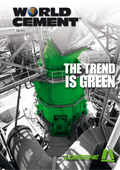Editorial comment
Over the past five years, the cement industry has witnessed some turbulent times. Economic recession has overlapped with a clamp down on emissions in some places and political discord in others. For some companies, one or other of these has been the proverbial straw that broke the camel’s back. The question frequently asked among conference-goers is ‘Will we ever see the likes of 2005/2006 again?’ The answer I most often hear is ‘No; those days are gone’, but is that really true?
Register for free »
Get started now for absolutely FREE, no credit card required.
Look back 15 years or so to the Asian Financial Crisis. Thailand, Indonesia and Malaysia were all badly affected by the recession that followed the initial financial collapse. Now flick through to page 48, the Asia & Pacific Rim section of our World Review, and see just how far these countries have come. The Asian Financial Crisis was a stumbling block – a lengthy speed bump, if you will, on a continued path to growth. That period is now firmly in the past, but has no doubt left the respective governments with lessons learned and mistakes not to be repeated.
The difference in a Southeast Asian crisis compared to a global economic downturn is not only in magnitude and geographic spread. The advantage that the Southeast Asian economies had – and continue to have – over North America and Western Europe is that they had a lot more room to grow. Recovery in the more developed economies has been slower, but with recent news of a new cement plant being built in Quebec and expansion plans for the Cemex plant in Odessa, Texas, things are looking up. The latest USGS figures put cement production up 4% in March and the PCA predicts overall growth in cement consumption of 6.2% in 2H13, rising to 9.2% in 2014. The future is certainly brighter.
Protests in Brazil are in their very early days at the time of writing and the noise from Turkey seems to have subsided, but instability in either country could threaten what otherwise promises to be a long-term stronghold for the cement industry. Of course, governments know that foreign investment is dependent on creating a viable business environment and, looking through the countries featured in the World Review, it is evident that those governments that dealt swiftly and proactively with civil unrest are fairing better than those which let it drag out. Again, it’s a question of ‘watch this space’.
Of course, World Cement’s international contracts coverage is not limited to this annual World Review. Aside from the news and reports featured in every issue, we also have a ‘Regional Insight’ section on our website, www.worldcement.com, where you can search for news by geographic area of interest using a handy map. Finally, a brief thank you to all those who have supported our World Review by sending in their updates. If you have news to share with the industry, please send it along to katherine.guenioui@worldcement.com

